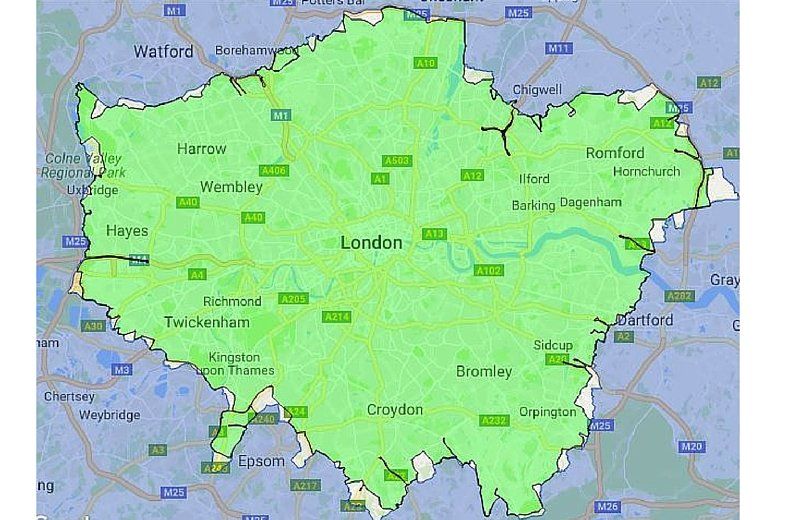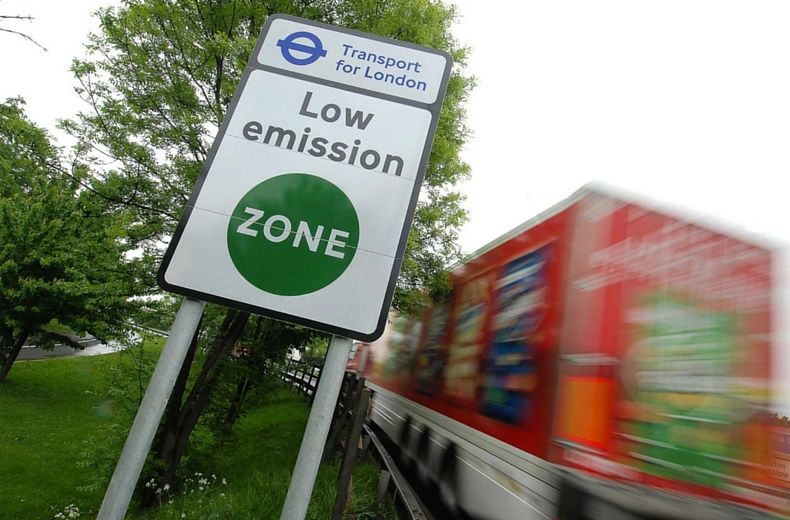As air quality becomes an increasingly political issue, measures are being put in place to discourage more polluting vehicles from entering areas where air quality is poor.
Low Emission Zones (LEZs) have been identified by the UK government – as part of its air quality plan – as one way that local authorities can reduce harmful emissions in specific areas.
A Low Emission Zone already exists in London, and LEZs have also been implemented in many cities across Europe, although many drivers remain confused about what they mean in practice.
Here, we will tackle the issue head on, explaining everything you need to know about LEZs – from what they are to how they will affect you.
A Low Emission Zone is very similar to another scheme to promote lower air pollution: the Clean Air Zone (CAZ) initiative.
Information correct as of December 2022.
What is a Low Emission Zone?
Low Emission Zones are schemes that cover specific areas (typically in cities) designed to tackle air pollution. They discourage certain types of vehicles from entering a specified zone.
Typically, this will consist of a charge for the vehicle, should it not reach a minimum standard for emissions to enter this zone.
The idea is to encourage the use of less polluting vehicles to improve air quality.
LEZs are becoming increasingly popular across Europe. In the UK, the London Low Emission Zone is the nation’s largest and most comprehensive.
LEZs do not actually forbid higher-emission vehicles from entering, but daily charges to enter the zone are enforced. Failure to pay the designated charge may result in heavy financial penalties.
To find out if your vehicle makes you liable for a charge, read our daily charges section below.
Where are the UK's Low Emission Zones?
There are Low Emission Zones in:
- London
- Brighton
- Birmingham
- Bristol
- Bath
- Bradford
- Portsmouth
- Newcastle
- Norwich
- Nottingham
- Oxford
- Aberdeen
- Dundee
- Edinburgh
- Glasgow
Several other major cities such as Manchester and Sheffield are in discussions about introducing them in the near future.
With the exception of the London and the Scottish city LEZs, these zones currently only affect local buses, so members of the public do not have to pay to enter them.
Many believe that, as inner-city pollution levels worsen, more cities will bring in LEZs that include a wider range of vehicles – including cars. This is already happening in some Clean Air Zones.
The government’s air quality plan pledges to ‘be the first generation to leave the environment in a better state than we inherited it’.
It has a particular focus on roadside nitrogen oxide (NO2) concentrations, which are linked to cancer and respiratory diseases.
Local authorities can propose and implement LEZs – along with other schemes such as congestion charging – to help reduce NO2.
Each authority will have details on its website about the specifications used to implement a Low Emission Zone.
The London Low Emission Zone
The London LEZ was introduced in late 2008 and covers most of Greater London, including parts of the M1 and M4 motorways (but not the M25).
Unlike the London Congestion Charge, it operates 24 hours a day, every day of the year.
As the London Low Emission Zone is a separate scheme to the London Congestion Charge, drivers of vehicles affected by the London LEZ who also enter the central Congestion Charge zone must pay both charges during the daytime on a weekday.
Vehicle owners should check where the boundaries of each zone are before entering London.
Here is a map to show you exactly where the Low Emission Zone covers.

The zone is automatically enforced by Automatic Number Plate Recognition (ANPR) cameras, as opposed to barriers or toll booths.
Entry points for the London Low Emission Zone are well marked by clear signage as shown below.
There are additional reminder signs within the zone, too – plus signs before the zone offering diverted routes in case you do not wish to enter.
What vehicles are affected by the London Low Emission Zone?
At the moment, it is only larger vehicles that are affected by the London Low Emission Zone: pre-October 2006 lorries over 3.5 tonnes, coaches over five tonnes, larger vans, minibuses and motorised caravans.
Light 4x4s and pick-ups registered new before 1 January 2002 are also required to pay it.
You can use the Transport for London LEZ guide and enter your registration number to see if your vehicle is affected, and if you will have to pay to enter the zone.
One thing to note is that if you drive an HGV over 12 tonnes in Greater London at any time, you will need an HGV Safety Permit to show that your vehicle meets the Direct Vision Standard (DVS). Vehicles without a permit will be subject to a penalty charge notice. Applying for a permit is free.
In October, major changes were announced regarding the future of London’s low emission zone.

RAC Roadside Cover from £5.49 a month
That's cheaper than AA!*
*At least 10% of new customers paid this or less since 12/08. Comparison based on theaa.com closest equivalent cover at 03/01.

What will it cost me to enter the London Low Emission Zone?
That depends on what you are driving and where you are. This table should give a clear indication on how much you are likely to pay.
| Vehicle | Weight | Daily charge |
|---|---|---|
| Larger vans, motorised horseboxes, 4x4 light utility vehicles, pick-ups, other specialist vehicles that do not meet Euro 3 emission standards | 1.205 tonnes unladen or more | £100 |
| Motor caravans, ambulances that do not meet Euro 3 emission standards | 2.5-3.5 tonnes gross vehicle weight | £100 |
| Minibuses (with more than eight passenger seats) that do not meet Euro 3 emission standards | 5 tonnes or less gross vehicle weight | £100 |
| Lorries, goods vehicles, motor caravans, motorised horseboxes, breakdown and recovery vehicles, snow ploughs, gritters, refuse collection vehicles, road sweepers, concrete mixers, tippers, fire engines, removals lorries, other specialist vehicles that do not meet Euro 6 (NOx and PM) emission standards, but meet Euro 4 (PM) | More than 3.5 tonnes gross vehicle weight | £100 |
| Lorries, goods vehicles, motor caravans, motorised horseboxes, breakdown and recovery vehicles, snow ploughs, gritters, refuse collection vehicles, road sweepers, concrete mixers, tippers, fire engines, removals lorries, other specialist vehicles that do not meet Euro 4 (PM) emission standards | More than 3.5 tonnes gross vehicle weight | £300 |
| Buses, coaches (with more than eight passenger seats) that do not meet Euro 6 (NOx and PM) emission standards, but meet Euro 4 (PM) | More than 5 tonnes gross vehicle weight | £100 |
| Buses, coaches (with more than eight passenger seats) that do not meet Euro 4 (PM) emission standards | More than 5 tonnes gross vehicle weight | £300 |
Should you wish to avoid paying the charge altogether, you can have an approved filter fitted – or choose to buy a cleaner vehicle.
The Low Emission Zone operates 24 hours a day, every day of the year, including weekends and public holidays.
Daily charges should be paid before midnight of the third charging day following the journey.
Charging days run from midnight to midnight, so if you were to drive within the LEZ between 23:30 and 01:00 the next day, you would need to pay for two days.
Vehicles parked in the zone but not driving are not subject to LEZ charges for that day.
Clean Air Zone vehicle checker
The Government’s Joint Air Quality Unit has an online vehicle checker to help drivers prepare for Clean Air Zones.
Just enter your vehicle’s registration number and this free tool will tell you if there will be a daily charge to drive your vehicle in a specific zone. More cities will be added as final plans become approved.
What is the Ultra Low Emission Zone?
As inner-city pollution worsens, Low Emission Zones will become a key tool in helping authorities to control emissions without the need for an outright ban on certain vehicles entering city areas. They are predicted to become much more commonplace than today.
An Ultra-Low Emission Zone (ULEZ) was introduced in London in April 2019 by Mayor Sadiq Khan, following proposals by the previous Mayor of London, Boris Johnson. The original London ULEZ covered the same area as the Congestion Charge Zone.
The boundaries of the original ULEZ were expanded on 25 October 2021 to include all areas within the North and South Circular Roads but not the North and South Circular roads themselves.
The ULEZ replaces the previous T-Charge.
Where are Europe’s Low Emission Zones?
Fifteen European countries operate LEZs, with more than 200 cities and towns having schemes in place.
The list is likely to grow over time, so if you’re planning a trip abroad, we advise using this website to check if the area you’re driving in has a Low Emission Zone in place. It offers all the advice and information you need.
A European LEZ, just like in the UK, means certain vehicles are restricted from driving into these areas, which are usually well marked out by signs.
In Germany, LEZs are called Umweltzone and there are over 80 schemes in operation, in both major cities and smaller towns.
For more advice on driving in Germany and German LEZs visit our driving in Germany guide.
They are also commonplace in Italy, with over 100 schemes covering cities and even whole regions (for example, the entirety of Lombardia).
Four cities in the Netherlands now have car and van LEZs, in addition to schemes affecting only lorries.
Austria, Denmark, Finland and Sweden operate LEZs for larger heavy goods vehicles. Belgium, the Czech Republic, France, Greece, Norway, Portugal and Spain all have at least one LEZ that affects, or will soon affect, cars as well. Stockholm in Sweden already charges cars, minibuses and vans to enter its Low Emission Zone, which came into being on 15 January 2020.
Many towns and cities also have traffic restrictions. For example, more than 200 Italian cities have areas where traffic is very restricted, often to residents only, called ‘ZTLs’ (Zona a Traffico Limitato). These regularly result in expensive fines. Find out where ZTLs are and how to avoid the fines here.
Get 30 driving tips that will save you money
Running a car isn’t cheap, but there are some easy things you can do to keep your costs down. Get these tips and more useful driving articles sent straight to your inbox now.











